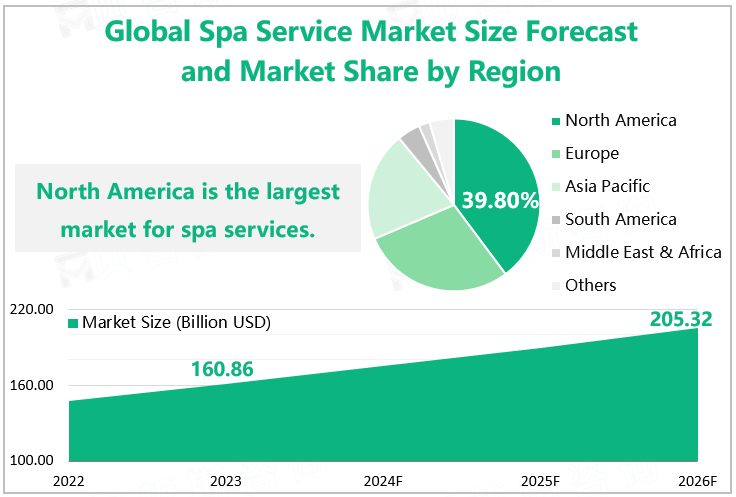Spa services are a water-based health therapy. It
uses water with different temperatures, pressures, and solute contents to act
on the human body in different ways. It can not only help people reduce body
tension and stress, restore energy, and improve blood circulation but also
serve as a comprehensive health therapy to promote personal physical and mental
health and overall well-being. Therefore, spa services are increasingly favored
by consumers in modern society.
Introduction to Subdivision Types
|
Classification by usage method
|
-
Immersion bath
-
Shower
-
Spray bath
-
Whirlpool water bath
-
Bubble bath
|
|
Classified by temperature
|
-
High-temperature water bath
-
Warm water bath
-
Flat-temperature water bath
-
Cold water bath
|
|
Classified by drugs contained
|
-
Carbonate bath
-
Pine resin bath
-
Salt water bath
-
Starch bath
|
Source: www.globalmarketmonitor.com
Overview of Market Development and Analysis of Market Development in Major Regions
In recent years, thanks to the improvement of people's living standards, the enhancement of health awareness, and the unique advantages of spa services in physical and mental relaxation and health care, spa services have gradually become a popular leisure way. The global spa service market is showing a steady growth trend, and the market size is constantly expanding. According to our research data, the global spa service market size reached $160.86 billion in 2023, among which the three major regions of North America, Europe, and the Asia Pacific had a total market share of nearly 90%, making them the main markets for global spa services.
As the largest market in the global spa services industry, North America holds approximately 40% of the market share. This is mainly due to the advanced technology and equipment in the region, such as intelligent spa devices, virtual reality experiences, etc. These innovations have brought more opportunities and potential to the market.
The European region also holds an important position in the spa service market, accounting for approximately 30% of the global market share. The European spa service market is mainly dominated by high-end and luxurious spa centers, which usually provide one-stop services, including massage, sauna, steam bath, etc., to meet consumers' pursuit of high-quality life. In addition, the European spa service market is also influenced by its profound cultural and historical heritage, with many spa centers incorporating local cultural elements, providing consumers with a unique experience.
The Asia Pacific region accounts for about 20% of the market share and is expected to maintain rapid growth in the coming years. This is mainly due to the rise of emerging cities such as China and India, where consumers are increasingly valuing health and physical and mental relaxation, and the demand for spa services is also increasing. In addition, the spa service market in the Asia Pacific region has also been influenced by its unique culture and traditions, for example, the spa concept of traditional Chinese medicine has received widespread attention and application in the Asian region.
Global Spa Service Market Size Forecast and Market Share by Region
Source: www.globalmarketmonitor.com
Market development prospect prediction
In the future, there is still great potential for development in the global spa service market. On the one hand, with the continuous progress of technology, the field of spa services will continue to innovate. For example, introducing more intelligent devices, virtual reality technology, etc. to provide consumers with a richer and more diverse spa experience. On the other hand, emerging markets such as Asia, the Middle East, and Latin America will also become important growth points in the global spa service market, and consumers in these regions will become the main driving force of the market. It is expected that by 2026, the global spa service market size will increase to $205.32 billion. However, market competition will become increasingly fierce, and major spa service providers will seek innovation and differentiated development.
